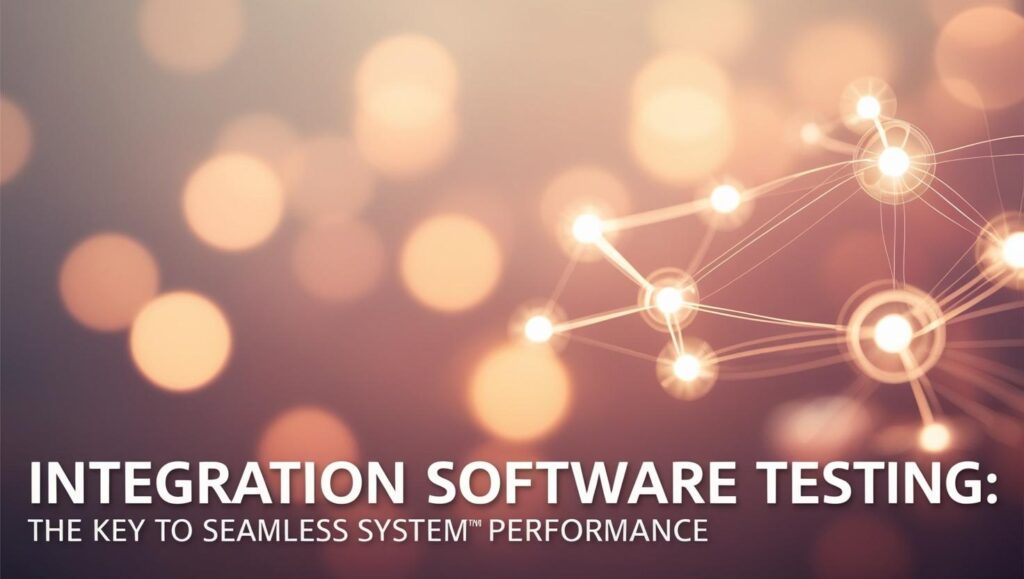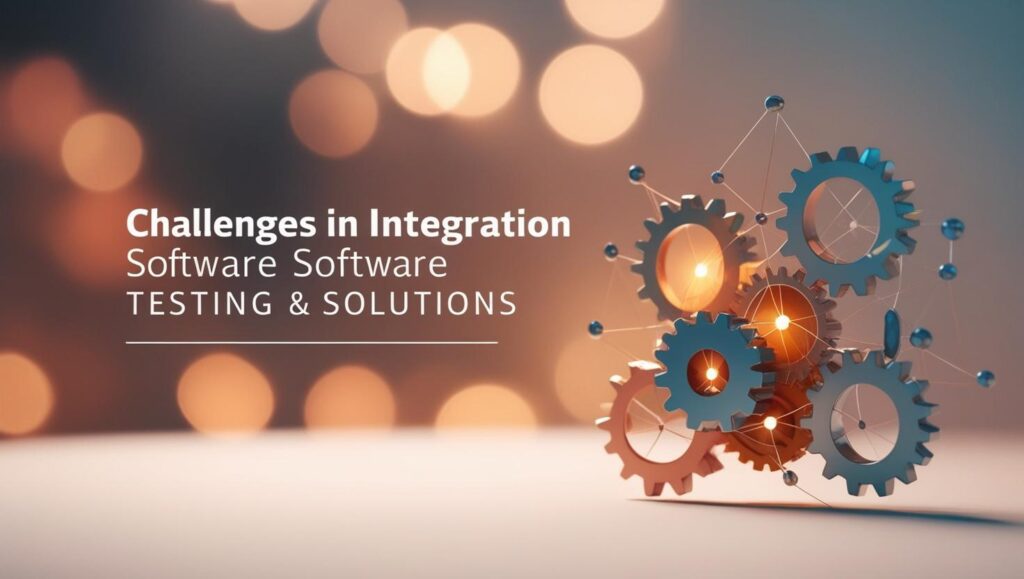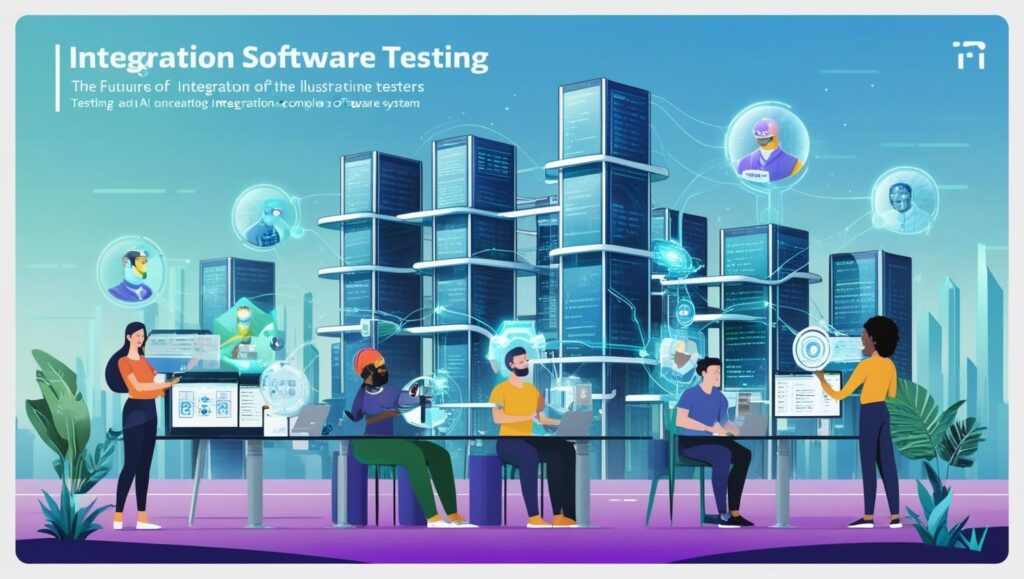Integration Software Testing: The Key to Seamless System Performance
In today’s digital world, businesses rely on multiple software applications to run smoothly. But when these systems don’t integrate well, errors arise, processes slow down, and user experience suffers. Integration Software Testing ensures seamless communication between internal modules, third-party apps, and APIs, preventing glitches and system failures.
With the rise of cloud computing, microservices, and API-driven systems, integration testing is more crucial than ever.
Developers and testers use automation tools to detect and fix issues early, ensuring reliability.
In this blog, we’ll cover:
✅ What Integration Software Testing is and why it matters
✅ Best practices for effective integration testing
✅ The role of API testing and automation in software reliability
✅ Top tools to streamline integration testing

What is Integration Software Testing & Why It Matters
Integration Software Testing Software applications, like a well-built house, must have properly connected components to function smoothly. Integration Software Testing ensures that different modules, APIs, databases, and third-party services communicate effectively, preventing crashes, incorrect data transfers, and workflow disruptions.
Unlike unit testing, which examines individual components, Integration Software Testing focuses on how these components interact, detecting issues such as.
✔️ Incorrect data exchange
✔️ API communication failures
✔️ Software incompatibilities
✔️ System workflow breakdowns
How is Integration Software Testing Different from System Testing?
Many people confuse Integration Software Testing with system testing, but they serve different purposes:
| Feature | Integration Software Testing | System Testing |
|---|---|---|
| Focus | Checks interactions between software modules and APIs | Tests the entire system as a whole |
| Objective | Ensures smooth communication between components | Validates the system against business requirements |
| Scope | Limited to connected components | Covers the entire application |
| Examples | API calls, database connections, microservices integration | Load testing, UI testing, security checks |
Since modern applications rely heavily on APIs and cloud-based integrations, API software testing has become a critical part of integration software testing. Businesses use it to ensure that APIs function correctly, data flows smoothly, and end-users don’t experience disruptions.
Why is Integration Testing Essential?
Modern software relies on APIs and external integrations—when they fail, businesses suffer:
🔴 Banking apps may fail transactions due to API miscommunication.
🔴 E-commerce sites could lose orders if payment gateways aren’t properly integrated.
🔴 Healthcare systems might misplace records due to database sync issues.
These failures cost businesses millions, harm reputations, and frustrate users. Integration Software Testing is critical to preventing such costly disruptions.
Key Benefits of Integration Software Testing
✔️ Prevents System Failures – Ensures smooth module interaction, preventing crashes and malfunctions.
✔️ Improves Data Accuracy – Verifies correct data exchange between integrated components.
✔️ Enhances API Performance – Keeps APIs stable, fast, and secure to avoid performance issues.
✔️ Supports Automation – Reduces manual effort, speeds up testing, and ensures consistency.
✔️ Ensures Seamless User Experience – Prevents glitches that frustrate users and impact engagement.
✔️ Saves Time & Costs – Detects issues early, reducing expensive post-deployment fixes.
Types of Integration Software Testing
Different testing methods ensure seamless software Integration Software Testing based on system structure and component interactions:
1️⃣ Big Bang Testing – All modules are tested together, making it fast but risky for debugging. Integration Software Testing Best for small, well-tested projects.
🔍 Example: A mobile banking app integrates login, transactions, and notifications in one go.
2️⃣ Incremental Testing – Tests modules in stages, allowing easier debugging. Ideal for complex systems with dependencies.
🔍 Example: An e-commerce site first tests its product catalog, then shopping cart, then payment gateway.
3️⃣ Top-Down Testing – Starts with high-level modules, integrating lower-level ones gradually. Uses stubs to mimic missing components.
🔍 Example: A CRM system first tests its dashboard, then adds contact management and email automation.
4️⃣ Bottom-Up Testing – Begins with lower-level components, moving upwards. Uses drivers to simulate higher-level functionality.
🔍 Example: A finance app tests transaction processing before integrating reporting and dashboard features.
5️⃣ Hybrid (Sandwich) Testing – Combines Top-Down and Bottom-Up approaches, reducing reliance on stubs and drivers.
🔍 Example: A medical records system tests both data input forms and database storage simultaneously.
6️⃣ API Testing – Ensures APIs send/receive correct data, remain secure, and perform under heavy loads.
🔍 Example: Tools like Postman, SoapUI, and JMeter validate API reliability and efficiency.
How Integration Software Testing Works
Integration Software Testing follows a structured process to ensure seamless software interactions:
1️⃣ Requirement Analysis & Planning – Identify test components (APIs, databases, third-party services), define test scenarios, choose a testing approach, and select automation tools.
📌 Example: Testing how an e-commerce site’s catalog, cart, and payment system interact.
2️⃣ Test Environment Setup – Configure real-world conditions, integrate necessary components, and use stubs/drivers for missing modules.
📌 Example: Mimicking API responses when an external service is unavailable.
3️⃣ Executing Test Cases – Run test cases to verify system interactions, focusing on API communication and automation.
📌 Example: A banking app testing seamless data transfers between mobile, backend, and payment systems.
4️⃣ Logging & Fixing Defects – Identify errors, debug API/database interactions, and resolve integration failures.
📌 Example: Fixing incorrect flight prices in a travel booking system due to faulty database retrieval.
5️⃣ Regression Testing – Re-run tests after fixes to ensure stability and automate performance validation.
📌 Example: Ensuring customer data syncs correctly in a CRM after updates.
6️⃣ Final Validation & Deployment – Perform end-to-end testing, document results, and monitor for real-world issues post-deployment.
📌 Example: Verifying hospital records update correctly in a healthcare system after release.
Challenges in Integration Software Testing & Solutions

1️⃣ Data Inconsistencies – Different modules may process data differently, causing mismatches.
✅ Solution: Standardize data formats and validate exchanges.
📌 Example: Payroll and finance systems must sync salary details correctly.
2️⃣ Third-Party API Dependencies – External APIs may be slow, unavailable, or return incorrect data.
✅ Solution: Use stubs/mocks to simulate API responses.
📌 Example: An e-commerce site should test how it handles failed
payment transactions.
3️⃣ Complex Workflows – Large systems have multiple integration points, making manual testing inefficient.
✅ Solution: Automate repetitive test cases.
📌 Example: A logistics platform must test warehouse, inventory, and shipping system interactions.
4️⃣ Environment Configuration Issues – Differences in databases, APIs, and authentication cause failures.
✅ Solution: Set up dedicated test environments and automate provisioning.
📌 Example: A healthcare app must test integrations across multiple hospitals.
5️⃣ Performance Bottlenecks – High API requests and database queries can slow down response times.
✅ Solution: Conduct load testing and optimize system queries.
📌 Example: A video streaming service must test CDN performance under heavy traffic.
6️⃣ Limited Test Data – Insufficient or restricted data affects real-world testing.
✅ Solution: Use test data generation tools and anonymized datasets.
📌 Example: A banking system should test transactions using dummy accounts.
Best Practices for Successful Integration Software Testing
1️⃣ Start Early – Detect and fix Integration Software Testing issues early with Shift-Left Testing to avoid costly fixes later.
📌 Example: A travel booking site should test flights, hotels, and payments early in development.
2️⃣ Automate Testing – Use CI/CD pipelines and automation tools like Selenium, JUnit, and Postman to improve accuracy and efficiency.
📌 Example: A financial app should automate API and UI integration tests.
3️⃣ Simulate Real-World Scenarios – Test for high traffic, API failures, and data corruption to ensure robustness.
📌 Example: A ride-sharing app should test cancellations during payment processing.
4️⃣ Prioritize API Testing – Use tools like Postman and JMeter to validate API responses, security, and performance at every stage.
📌 Example: A weather app must check API accuracy and response time.
5️⃣ Implement CI/CD & Regression Testing – Automate integration tests to catch failures before production and ensure updates don’t break existing functionality.
📌 Example: A CRM platform should verify customer data syncs after every update.
6️⃣ Monitor & Debug Proactively – Use system logs and real-time monitoring to detect hidden integration issues.
📌 Example: A stock trading platform should monitor API latency to prevent price update delays.
7️⃣ Test Across Environments & Devices – Validate integrations across different operating systems, browsers, and network conditions for cross-platform compatibility.
📌 Example: A video conferencing app should be tested on Windows, macOS, Android, and iOS.
Top Tools for Integration Software Testing
1️⃣ Postman – Automates API testing, vali dates requests, responses, and authentication in CI/CD pipelines.
📌 Best for: API testing (REST, SOAP), automation.
2️⃣ Selenium – Tests web applications, ensuring UI components interact smoothly across browsers.
📌 Best for: UI integration testing, web automation.
3️⃣ JUnit & TestNG – Java-based frameworks for automating database, API, and workflow testing.
📌 Best for: Java-based integration and system testing.
4️⃣ SoapUI – Validates SOAP and REST APIs, ensuring secure and stable integrations.
📌 Best for: API-based enterprise application testing.
5️⃣ JMeter – Conducts performance and load testing to assess system scalability under high traffic.
📌 Best for: API load testing, performance optimization.
6️⃣ Cypress – Automates front-end testing with real-time execution for modern web applications.
📌 Best for: End-to-end UI and integration validation.
7️⃣ Tricentis Tosca – A low-code automation tool for testing APIs, databases, and UI in CI/CD pipelines.
📌 Best for: Enterprise integration and DevOps testing.
8️⃣ Cucumber – Uses behavior-driven testing (BDD) to align testing with business requirements.
📌 Best for: BDD-based integration testing, automation scripting.
Future of Integration Software Testing

1️⃣ AI & Machine Learning – AI-driven tools predict failures, optimize test cases, and improve accuracy by analyzing past results.
📌 Example: AI automation platforms detect API failure patterns and suggest fixes.
2️⃣ Cloud-Based Testing – Scalable cloud environments enable large-scale integration testing without costly infrastructure.
📌 Example: CRM migration tests ensure smooth cloud and on-premise integration.
3️⃣ API-First Development – APIs are designed and tested before full system development, with a focus on security.
📌 Example: IoT smart home systems require robust API integration testing.
4️⃣ Microservices & Containerized Testing – Docker and Kubernetes help isolate and test microservices efficiently.
📌 Example: A food delivery app tests order processing, payments, and restaurant management integration.
5️⃣ Shift-Left Testing – Early integration testing in CI/CD pipelines reduces costs and development delays.
📌 Example: Banking software runs automated API tests in CI/CD to prevent payment failures.
6️⃣ Security & Compliance Focus – Ensures APIs, encryption, and third-party integrations meet GDPR, HIPAA, and PCI-DSS standards.
📌 Example: Healthcare apps verify secure patient data exchange between hospitals and insurers
Conclusion
Integration Software Testing ensures seamless communication between software components, APIs, and external systems, preventing data inconsistencies, system failures, and poor user experience.
By adopting best practices, automation tools, and API testing, businesses can detect issues early, improve performance, and deliver reliable solutions. As technology advances, AI-driven automation, cloud testing, and microservices will continue shaping integration testing.
For enterprise applications, cloud services, or API-driven platforms, investing in robust integration testing saves time, reduces costs, and enhances user experience.
Optimize your software integration today for error-free, high-performance applications!
Frequently Asked Questions (FAQs)
What is Integration Software Testing?
It ensures software components, APIs, and systems work together seamlessly, preventing failures and data issues.
How is API Software Testing related to Integration Testing?
APIs enable system communication. API testing verifies data flow, functionality, and security.
What are the main types of Integration Testing?
✔️ Big Bang – Tests all modules together.
✔️ Incremental – Tests modules in stages.
✔️ Hybrid – Combines Big Bang & Incremental.
✔️ API Testing – Ensures API interactions function properly.
Best tools for Integration Testing?
✔️ Postman – API testing
✔️ Selenium – UI testing
✔️ JUnit & TestNG – Java-based testing
✔️ SoapUI – Web services testing
✔️ JMeter – Performance testing
How does automation help in Integration Testing?
It speeds up testing, reduces errors, improves accuracy, and supports CI/CD pipelines.
Key challenges in Integration Testing?
✔️ Data mismatches
✔️ Third-party API failures
✔️ Complex workflows
✔️ Performance issues
✔️ Environment setup difficulties
How can businesses ensure successful Integration Testing?
✔️ Start early
✔️ Automate tests
✔️ Validate API interactions
✔️ Simulate real-world scenarios
✔️ Monitor system performance
How does Integration Testing fit into DevOps & CI/CD?
It detects issues early, maintains system stability, and automates testing in continuous development.
What is the future of Integration Testing?
✔️ AI-driven automation
✔️ Cloud-based testing
✔️ Advanced API security testing
✔️ Microservices testing
How to get started with Integration Testing?
✔️ Define integration points
✔️ Choose a testing approach
✔️ Use automation tools (Postman, Selenium)
✔️ Perform continuous testing & monitoring

